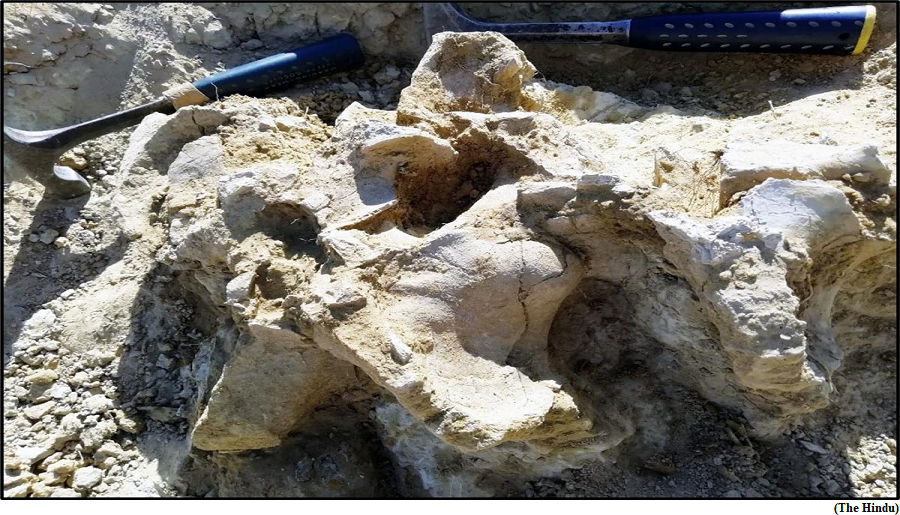Oldest yet fossils of a plant-eating dinosaur found in Rajasthan (GS Paper 3, Science and Technology)

Why in news?
- Recently the scientists from IIT Roorkee have characterised dinosaur fossils from the Middle Jurassic period, found in the Thar desert near the Jaisalmer Basin by the Geological Survey of India.
- They discovered that they had uncovered remains of a sauropod dinosaur, which is the same clade as the long-necked herbivores in Jurassic Park.
Genus:
- Belonging to the family Dicraeosauridae and from the superfamily Diplodocoidea, these fossils are the first dicraeosaurid sauropods to have been found in India. And at 167 million years old, they are the oldest known diplodocoid fossils in the world.
- The scientists named the dinosaur Tharosaurus indicus, with Tharo deriving from the Thar desert; saurus from the Greek ‘sauros’, or lizard; and indicus from its Indian origin.
Characteristic features:
- The most fascinating feature about sauropods is their size. They can grow more than a hundred feet. There are many sauropod groups that are even longer than the blue whale.
- However, members of the Dicraeosauridae family of sauropods, to which Tharasaurus belongs were not nearly as large. This family was unique: its members were smaller and had shorter necks and tails compared to the other long-necked sauropods.
- Sauropods first appeared on the earth during the Jurassic period, about 200 million years ago. They were one of the most dominant clades of dinosaurs, surviving until the late Cretaceous period 65 million years ago, when dinosaurs went extinct.
Importance of Indian landmass:
- Some 167 million years ago when Tharosaurus lived, India was not where it is now; it was part of a group of continents in the southern hemisphere with Africa, South America, Madagascar, and Antarctica, together called Gondwanaland.
- The scientists reasoned that these diplodocoid sauropods could have originated in India during the Middle Jurassic period and used the land connections at the time to migrate to Madagascar, Africa, and South America. After that they could have made their way to North America and the rest of the world.
- Another piece of evidence that supports their theory was that diplodocoid fossils in other continents like Africa, the Americas, and Asia come from a younger geological interval. This increases the possibility that the Indian landmass was the site for the Tharosaurus’ early radiation.
- That along with the fact that archaic sauropod fossils from during the start of the Jurassic period –like of Kotasaurus and Barapasaurus – were also found in India suggests that this diplodocoid group of sauropods could have evolved and originated in India.
More fossils needed:
- In 2006, an Indo-German team found another middle Jurassic sauropod dinosaur fossil in the Kutch basin of Gujarat, named Camarasaurus supremus, which was also the oldest fossil of that group found at the time.
- There have been subsequent finds of extremely old sauropod fossils in the region by the same team since.
Way Forward:
- Scientist believe that more work and more expeditions will need to be undertaken in the Jaisalmer area. This is a potentially important area for the Middle Jurassic dinosaurs in India.
Salient features and Guidelines of PM Vishwakarma Scheme
(GS Paper 2, Governance)
Why in news?
- PM Vishwakarma, a Central Sector Scheme, was launched on 17th September, 2023 by the Prime Minister to provide end-to-end support to artisans and craftspeople who work with their hands and tools.
- The Scheme covers artisans and craftspeople engaged in 18 trades, viz.(i) Carpenter (Suthar/Badhai); (ii) Boat Maker; (iii) Armourer; (iv) Blacksmith (Lohar); (v) Hammer and Tool Kit Maker; (vi) Locksmith; (vii) Goldsmith (Sonar); (viii) Potter (Kumhaar); (ix) Sculptor (Moortikar, stone carver), Stone breaker; (x) Cobbler (Charmkar)/ Shoesmith/Footwear artisan; (xi) Mason (Rajmistri); (xii) Basket/Mat/Broom Maker/Coir Weaver; (xiii) Doll & Toy Maker (Traditional); (xiv) Barber (Naai); (xv) Garland maker (Malakaar); (xvi) Washerman (Dhobi); (xvii) Tailor (Darzi); and (xviii) Fishing Net Maker.

The Scheme envisages provisioning of the following benefits to the artisans and crafts persons:
- Recognition: Recognition of artisans and craftspeople through PM Vishwakarma certificate and ID card.
- Skill Upgradation: Basic Training of 5-7 days and Advanced Training of 15 days or more, with a stipend of Rs. 500 per day;
- Toolkit Incentive: A toolkit incentive of upto Rs. 15,000 in the form of e-vouchers at the beginning of Basic Skill Training.
- Credit Support: Collateral free ‘Enterprise Development Loans’ of upto Rs. 3 lakh in two tranches of Rs. 1 lakh and Rs. 2 lakh with tenures of 18 months and 30 months, respectively, at a concessional rate of interest fixed at 5%, with Government of India subvention to the extent of 8%. Beneficiaries who have completed Basic Training will be eligible to avail the first tranche of credit support of upto Rs. 1 lakh. The second loan tranche will be available to beneficiaries who have availed the 1st tranche and maintained a standard loan account and have adopted digital transactions in their business or have undergone Advanced Training.
- Incentive for Digital Transaction: An amount of Re. 1 per digital transaction, upto maximum 100 transactions monthly will be credited to the beneficiary’s account for each digital pay-out or receipt.
- Marketing Support: Marketing support will be provided to the artisans and craftspeople in the form of quality certification, branding, onboarding on e-commerce platforms such as GeM, advertising, publicity and other marketing activities to improve linkage to value chain.
Beneficiaries:
- In addition to the above-mentioned benefits, the Scheme will onboard the beneficiaries on Udyam Assist Platform as ‘entrepreneurs’ in the formal MSME ecosystem.
- Enrolment of beneficiaries shall be done through Common Service Centres with Aadhaar-based biometric authentication on PM Vishwakarma portal.
- The enrolment of beneficiaries will be followed by a three-step verification which will include
- Verification at Gram Panchayat/ ULB level,
- Vetting and Recommendation by the District Implementation Committee
- Approval by the Screening Committee.



